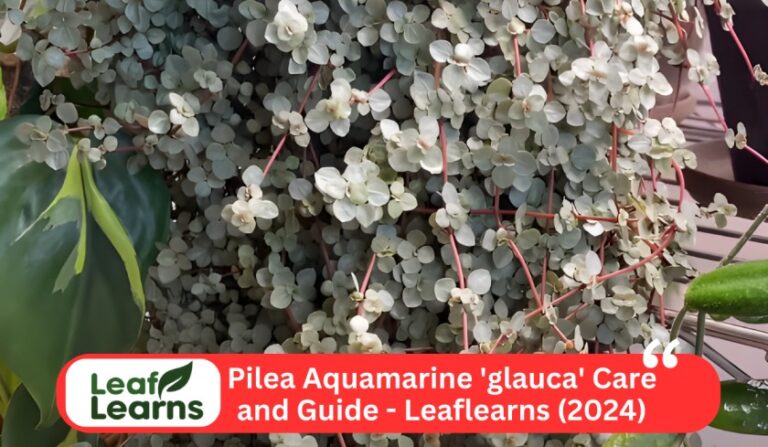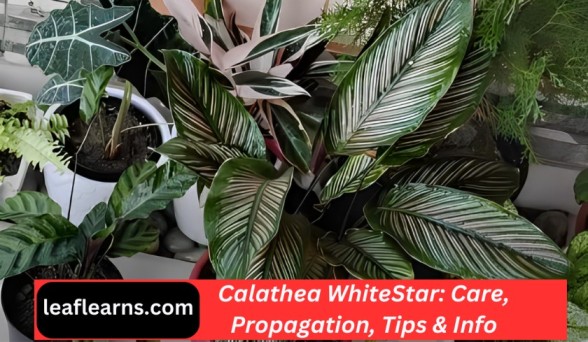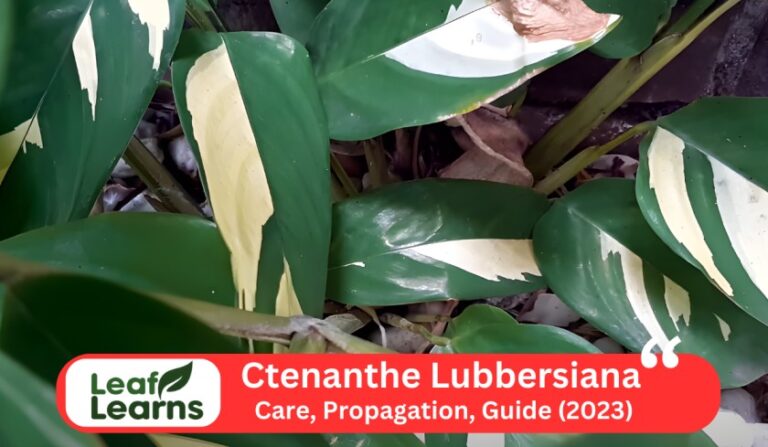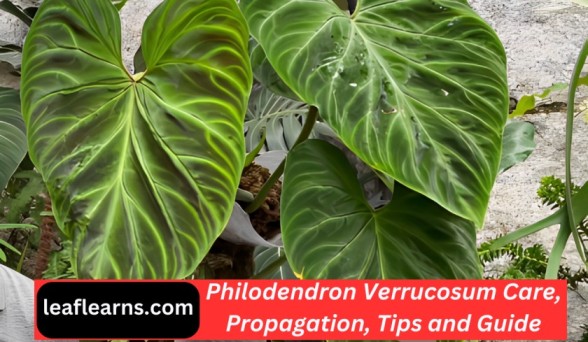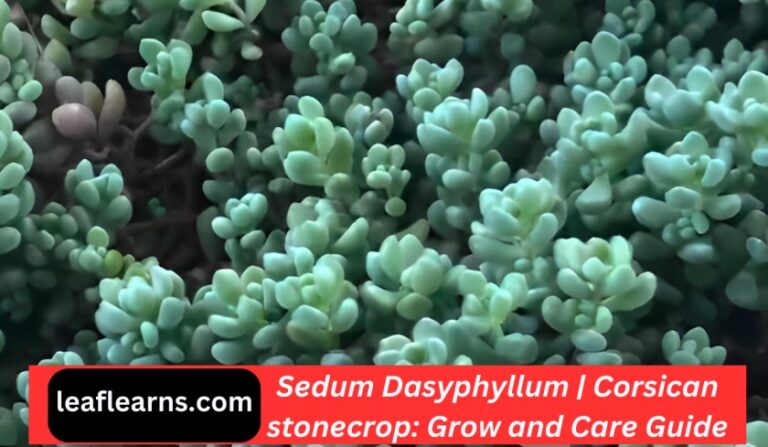Aglaonema Favonian Care Guide – Leaflearns (2024)
One of the most beautiful and easy houseplants is Aglaonema Favonian, informally called Chinese Evergreen ‘Favonian’, that gains popularity due to its wide leaves colored in pink. Unlike the majority of other Aglaonemas, it is characterized by rather bold and bright pink leaves which have a green edge and vein.

Being a unique blend of colors, this product truly is a show-stopper which gives life and embodiment to any room. This is a relatively slow-growing plant, which likes to be kept in shades or to be light deprived but prefers the bright indirect light for the best color vibrancy.
| Common Name | Aglaonema Favonian |
| Scientific Name | Aglaonema sp. ‘Favonian’ |
| Family | Araceae |
| Origin | Hybrid |
| Plant Type | Evergreen perennial |
| Size | Medium |
| Lifespan | Long-lived |
| Leaf Colour | Variegated, predominantly green with golden-yellow accents |
| Leaf Size | Medium |
| Flower | Infrequent, inconspicuous blooms |
| Light | Bright indirect light |
| Water | Moderate, allow soil to dry slightly between waterings |
| Soil | Well-draining potting mix |
| Temperature | 65-80°F (18-27°C) |
| Humidity | Moderate to high |
| USDA Zone | 10-11 |
| Fertilizer | Balanced liquid fertilizer every 2-4 weeks during growing season |
| Propagation | Stem cuttings, division |
| Pruning | Remove dead or yellowing leaves |
| Pests | Mealybugs, spider mites |
| Toxicity | Mildly toxic to pets and humans if ingested |
| Uses | Indoor decoration, air purification |
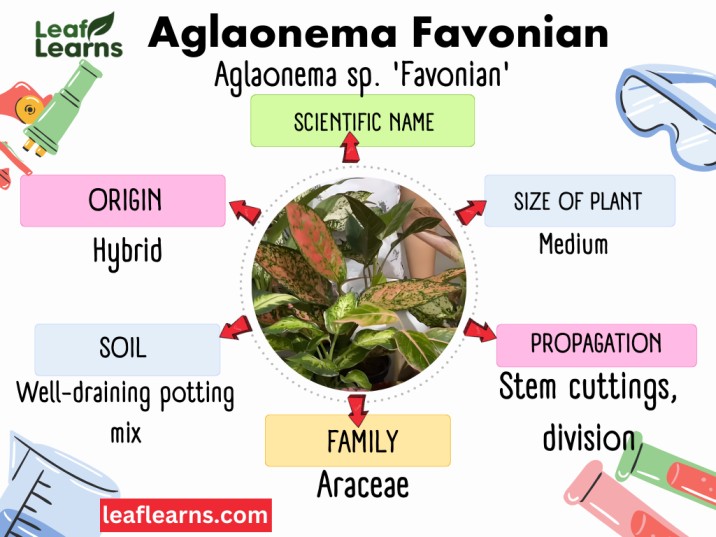
Contents
Aglaonema Favonian Care
Light Requirement
Although it prefers bright indirect sunlight for the most vibrant-colored flowers, this plant is easy to adapt even to medium and low light conditions.
Shun the sun and stay in some shady place, try as much as possible to avoid direct sunlight, especially during midday when it is harsh because it has the ability to burn the leaves.
As for summer, place it near the east-facing window or away from south ones. Therefore, winter needs to have more bright spots and even some of moving it near windows or grow lights may be considered.
The spring and fall make more options in this regard, so you are able to keep it in its normal place.
Water Requirements
Spring & Summer: This active period demands that watering be done more often. Once this layer is dry, immerse the pot and allow it to drain freely from them bottom.
Do not have wet soil, water that seeps out, should be eliminated. P, to achieve least once a week, let the watering adjust depending on your climate as well as pot size.
Fall: When growth changes and slows down, watering requirements are also reduced. Before subsequent drenching feed a thorough drink to the soil for the top 2 inches of the soil. Depending on pot size and climate, you should water every 10-14 days but remain observant.
Winter: Lapsed time consumes the least amount of water. Before you water the top 3 inches completely dry. However, if you are in a situation, it is possible to test the water only once in 2-3 weeks.
Soil Requirement
Choose a potting mix that is well-draining and helps to keep moisture but does not form and retain water.
Orchid potting mix is a combination of potting soil, perlite and orchid bark. Turn the soil over and apply water when the 1-inch layer of soil is dry, letting any extra moisture drain freely.
During summer, you might water more often so as to maintain the right moisture level, however, winter requires less frequent watering.
Do not forget to adapt this watering regime depending on the location of your pot and the size of your pot. Please recall that the beauty of this lovely plant is in overwatering and also in underwatering.
Temperature and Humidity Requirement
Summer
Temperature: Work towards a temperature range between 65°F and 80°F or from 18-27°C. Do not go above 85°F (30°C) when heat stress can burn leaves.
Humidity: The optimal humidity level should range from moderately high (50-70%) to high. Clustering of plants, a pebble tray/humidifier can work to increase the humidity.
Winter
Temperature: Maintain the temperature warm to comfortable levels at 60°F – 75°F or between 16°C and 24°C. Recommended are the fading drafts and drops below 55°F (13°C), which may lead to chills.
Humidity: Keep the humidity at a moderate level (between 40% and 50%) because over dry air can cause the leaf tips to brown. Misting seldom or a humidifier may also be used.
Spring and Fall
Temperature: Benefit from a large scope, 55°F to 85°F (13°C to 29°C). With temperatures not exceeding this range, your Favonian should be alright.
Pluck can be pushed a bit to account for other variables such as temperature and light. Greater humidity in spring may promote active growth, but the slightly lower legibility of water vapor in fall may help prevent fungal defacement.
Fertilizer and Potting Requirement
Summer
Fertilizer: When it is actively growing (favonian summer water diluted to half strength, liquid balanced fertilizer every 2-3 weeks. Choose nitrogen-rich formulas for nitrogen-based fertilizers to grow healthy leaves.
Potting: Provide that your Favonian lives in the well-drain pot with drainage holes. The appropriate blend would be an ordinary potting mix with some perlite or orchid bark for improved drainage.
Repot only when the plant reaches a size that no longer fits within its pot. This usually occurs once every year.
Spring & Fall
Fertilizer: Fertilize once a month during spring and fall in the dilute; as always. Meanwhile, a change for a balanced or higher-potassium fertilizer, favoring flower and fruit production (rare in houseplants) may be used.
Potting: If necessary, repotting is done during the spring or fall. Opt for a pot that is a bit bigger than the current one to ensure that it does not receive more water than required.
Winter
Fertilizer: If you are treating a winter dormant plant, completely stop fertilizing. At this close time, the plant only needs small amounts of nutrients.
Potting: Repotting should be avoided in winter, as the plant suffers major stress.
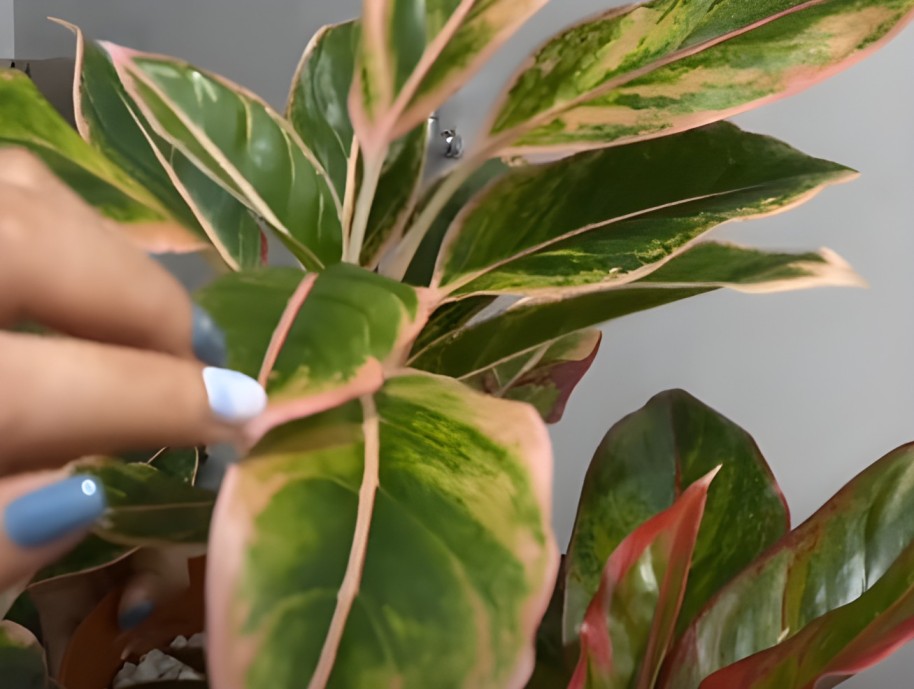
Aglaonema Favonian Propagation
Aglaonema sp. ‘Favonian’ with its vibrant pink foliage, makes a stunning addition to any home. Luckily, propagating this beauty is quite simple! Here are two effective methods to multiply your plant:
Stem Cuttings
Materials
- Sharp, sterilized pruners or shears
- Glass or jar (for water propagation)
- Well-draining potting mix (for soil propagation)
- Small pot with drainage holes
- Rooting hormone (optional)
Steps
- Choose a healthy stem: Choose a healthy stem, with approximately 2-3 leaves and about 4-6 inches long. Check for healthy firm and disease-free growth.
- Make the cut: Take sterilized pruners and make the second cut in a manner that is diagonal to a leaf node.
- Water propagation: Put a leaf node into clean water in a glass or jar that the leaf node is completely covered but the leaves aren’t covered with water. Add rooting hormone (optional) a few drops. Sunlight in a semi-shaded location, and change the water every week.
- It may take up to 2-4 weeks to appear root. Once the roots are well developed, put your plant in a pot with a soil mix that drains properly.
- Soil propagation: Place a small pot with drainage holes which will drain well in well-draining potting mix. If desired, dip the cut end in rooting hormone and plant it so that it will support the stem not buried. Sprinkle with water to keep the soil only moist but not soggy. Three to four weeks are an ideal duration for the roots to develop.
Division method
Materials
- Sharp, sterilized knife or pruners
- Potting mix
- New pots with drainage holes
Steps
- Gently dig the plant out of its container. Roll the root ball with hands.
- Identify natural divisions: Search for marked sections whose masses of leaves and roots are distinct from the rest. Gently split these parts of the fish with your hands and if it is needed, a sterile knife can be used for this.
- Repot each division: With each division in a pot, fill it with fresh and well-draining potting mix. Keep the plant well watered and in a bright, indirect light.
Growth Rate and Size
The Aglaonema Favonian is a Moderate houseplant that grows slowly. If all the conditions are perfect, you can expect it to add around 2-4 inches in height and width every year.
With this charmer, patience is a virtue, for it would take them 3 to 5 years ago to reach its full height of about 2-3 feet tall and wide.
Flowering
Comparatively, Aglaonema Favonian is technically able to flower, but blooming is very rare in the indoor-grown specimens.
And as for the flowers themselves, they are tiny and subtle, often buried in the leaves.
If your plant does blossom, you should regard it as a delightful bonus rather than a sure-thing to be seen Rather than ponder on its peculiar variegations, focus and relish the lush foliage.
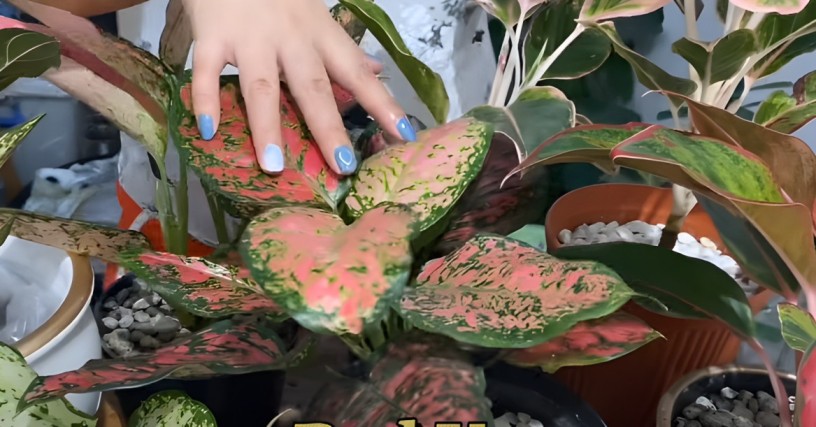
Foliage
The real showstopper of the story is Aglaonema sp. ‘Favonian’ with its strikingly different leaves. Its oval-shaped leaf features a stunning array of neon pink interior lightened by dark green borders and veins.
Such a bright dynamic makes a bright accent and adds the touch of tropicality to any room. The new leaves are usually lighter and sometimes the intensity is also lighted by the amount of light.
Common Pests and Disease
- Spider Mites: Small needle-suckers creating yellowing and webbing. Let the plant environment be humid, and use either insecticidal soap or neem oil.
- Apply alcohol on the ants, or use systemic insecticide.
- Aphids: Looper caterpillars are small, soft-bodied insects responsible for leaf curling and stunting.
Disease
- Root Rot: Often, overwatering results in soft roots and spindly stems. Rejuvenate drains, clean out the bad parts and repot.
- Neither wet the leaves of the plants while watering and make the air move.
- Fungal Leaf Spot: The brown circles surrounded by the yellow rings. Cut off the infested leaves and apply fungicide in case of severe morning glory.
Toxicity
Aglaonema Favonian are toxic to Humans, Cats and aslo dogs. The universality of insoluble calcium oxalate crystals in all the plant parts promotes irritation of the mouth, throat, and stomach upon ingestion. This applies to man and animals such as cats and dogs.
These symptoms include regurgitation and diarrhea, mouth pain, etc. Place the plant somewhere, where it will be not accessible by pets and children to avoid accidental poisoning.
If ingestion is suspected, a poison control center or the vet should be contacted right away.
Exploring the Diversity of Aglaonema Varieties
When exploring the vast array of Aglaonema varieties, enthusiasts often marvel at the diverse traits each species exhibits. From the striking patterns of the aglaonema variegata to the elegant hues of the aglaonema tricolor, the spectrum of colors and shapes is truly captivating.
Hybridization, such as the aglaonema hybriden and aglaonema kolbenfaden, further expands the possibilities, offering unique combinations that enthrall collectors worldwide.
These varieties, known as aglaonema-arten in German, showcase nature’s creativity and adaptability, making them popular choices for both seasoned gardeners and beginners alike.
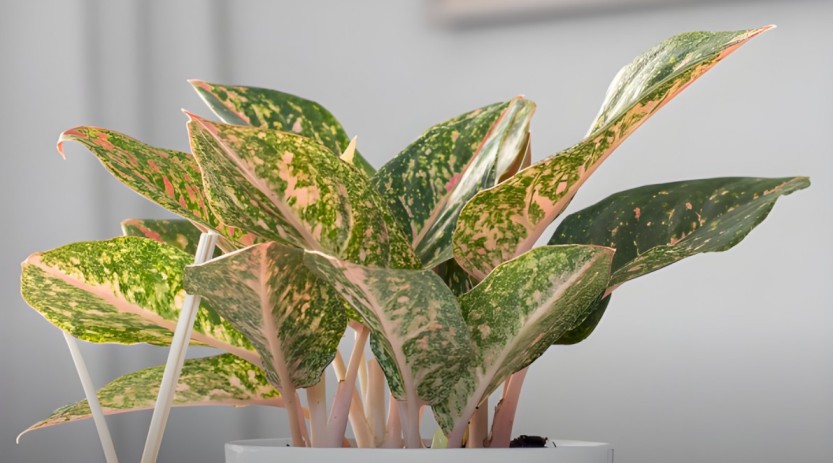
The Allure of the Favonian Series in Aglaonema Cultivation
Among the plethora of Aglaonema cultivars, the allure of the Favonian series stands out prominently. With names like aglaonema favonian gold and aglaonema-favonian silver, these plants exude an aura of elegance and refinement.
Enthusiasts eagerly share their experiences with aglaonema-favonian care, offering tips on nurturing these beauties to their full potential.
From the vibrant blooms of aglaonema-favonian flower to the soothing glow of aglaonema-favonian light, each aspect of their care contributes to their splendor.
Whether one is drawn to the vivid hues of aglaonema-favonian orange or the subtle charm of aglaonema-favonian white, these plants hold a special place in the hearts of collectors, adding a touch of sophistication to any botanical collection.
FAQs
How do you care for Aglaonema Favonian?
Light: Provide bright, indirect light. Avoid direct sun, which can scorch the leaves.
Water: Water when the top inch of soil dries out. Overwatering can lead to root rot.
Humidity: Moderate humidity (around 50%) is ideal, but this plant can tolerate lower humidity levels. Misting the leaves occasionally or using a pebble tray can help increase humidity.
Fertilizer: Fertilize monthly during spring and summer with a balanced fertilizer diluted to half strength.
Repotting: Repot every 1-2 years in well-draining soil. Choose a pot only slightly larger than the root ball.
What is the common name for aglaonema favonian?
Chinese Evergreen ‘Favonian’ is the common name for aglaonema favonian.

